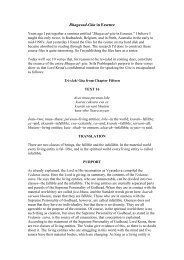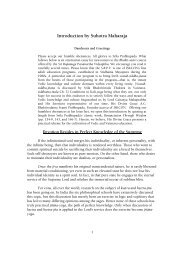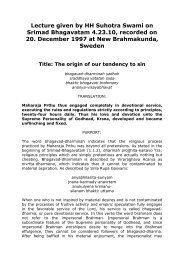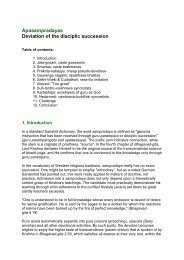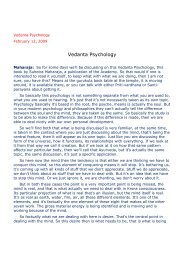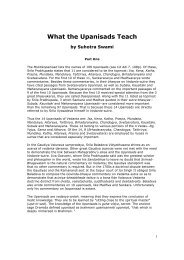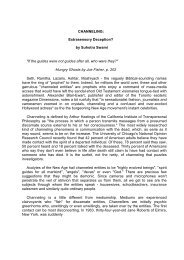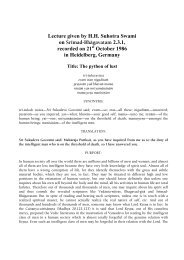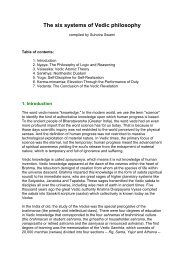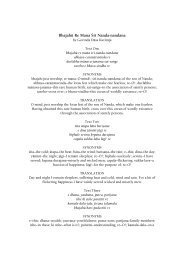artho 'yam brahma-sutranam - Suhotra Maharaja Archives
artho 'yam brahma-sutranam - Suhotra Maharaja Archives
artho 'yam brahma-sutranam - Suhotra Maharaja Archives
Create successful ePaper yourself
Turn your PDF publications into a flip-book with our unique Google optimized e-Paper software.
hetunanena kaunteya<br />
jagad viparivadate<br />
"This material nature is working under My direction, O son of<br />
Kunti, and it is producing all moving and unmoving beings. By its rule<br />
this manifestation is created and annihilated again and again."<br />
Day Five:<br />
7.15.54,55 -- Page 475<br />
7.15.50-51 -- Page 273<br />
This is explained in Bhagavad-gita (9.21):<br />
te tam bhuktva svarga-lokam visalam<br />
ksine punye martya-lokam visanti<br />
evam trayi-dhamaam anuprapanna<br />
gatagatam kama-kama labhante<br />
"When those who follow the pravrtti-marga have enjoyed heavenly<br />
sense pleasure, they return to this mortal planet again. Thus, through<br />
the Vedic principles, they achieve only flickering happiness."<br />
Following the pravrtti-marga, the living entity who desires to be<br />
promoted to the higher planetary systems performs sacrifices<br />
regularly, and how he goes up and comes down again is described here<br />
in Srimad-Bhagavatam, as well as in Bhagavad-gita. It is also said,<br />
traigunya-visaya vedah: "The Vedas deal mainly with the three modes of<br />
material nature." The Vedas, especially three Vedas, namely Sama, Yajur<br />
and Rk, vividly describe this process of ascending to the higher<br />
planets and returning. But Krsna advises Arjuna, traigunya-visaya veda<br />
nistraigunyo bhavarjuna: one has to transcend these three modes of<br />
material nature, and then one will be released from the cycle of birth<br />
and death. Otherwise, although one may be promoted to a higher<br />
planetary system such as Candraloka, one must again come down (ksine<br />
punye martya-lokam visanti). After one's enjoyment due to pious<br />
activities is finished, one must return to this planet in rainfall and<br />
first take birth as a plant or creeper, which is eaten by various<br />
animals, including human beings, and turned to semen. This semen is<br />
injected into the female body, and thus the living entity takes birth.<br />
Those who return to earth in this way take birth especially in higher<br />
families like those of <strong>brahma</strong>nas.<br />
7.15.56 -- Page 280<br />
3.30.33, 34 -- Page 280<br />
5.18.32 -- Page 281-282<br />
The different kinds of living entities coming from various sources<br />
are very clearly described in this verse. Some are born from a womb and<br />
some (like certain insects) from human perspiration. Others hatch from<br />
eggs, and still others sprout from the earth. A living entity takes<br />
birth under different circumstances according to his past activities<br />
(karma)<br />
2.2.24 -- Page 469<br />
8.5.36 -- Page 470<br />
7.15.54, 55 -- Page 475<br />
4.12.24, 25 -- Page 477-478<br />
Even in this material world the so-called scientists, philosophers<br />
and mental speculators strive to merge into the spiritual sky, but they<br />
can never go there. But a devotee, by executing devotional service, not<br />
only realizes what the spiritual world actually is, but factually goes<br />
there to live an eternal life of bliss and knowledge. The Krsna<br />
consciousness movement is so potent that by adopting these principles<br />
of life and developing love of God one can very easily go back home,<br />
back to Godhead. Here the practical example is the case of Dhruva<br />
<strong>Maharaja</strong>. While the scientist and philosopher go to the moon but are<br />
disappointed in their attempts to stay there and live, the devotee



